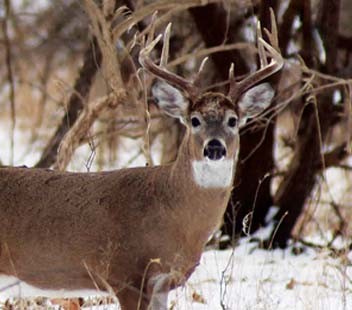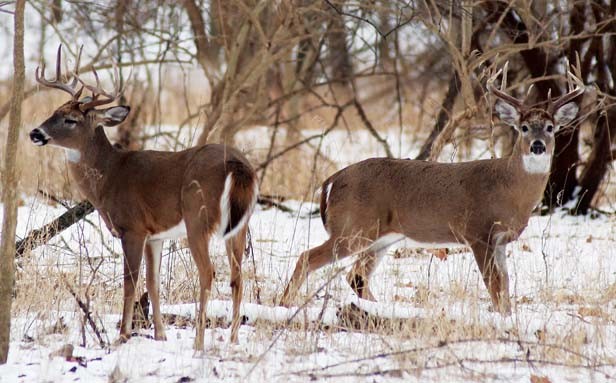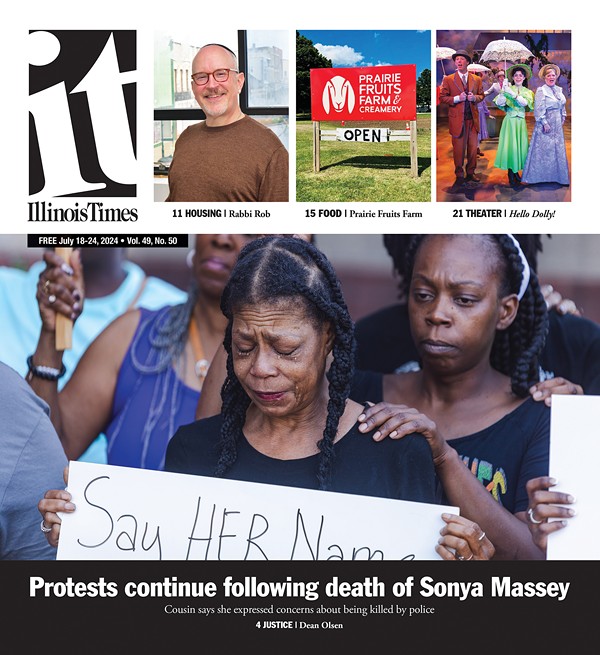Driving his pickup up a gravel road toward a built-in-a-weekend cabin on a 160-acre piece of land he calls a farm, Jack Robertson spots a pair of does munching on wheat that, along with oats and clover, is the only crop this place produces. That’s by design. He has tried soybeans and corn, but neither has taken in this hilly Pike County terrain that would give a combine fits. None of it is for human consumption.
The does bound off as Robertson approaches. Deer are what Robertson raises, or tries to raise, here. Since 1988, he has owned this place called Bucktrail Farm along with two partners, but the landowners remain more interlopers than residents. The cabin has neither indoor plumbing nor electricity, which is by choice in an area 70 miles west of Springfield where lodges with Jacuzzis beckon professional athletes, businessmen of all stripes and, of course, Ted Nugent.
At 4 p.m., Robertson, who owns a lawn-care business in Springfield, settles into a ground-level blind a short drive from the cabin, hangs his bow on a nearby hook and makes himself comfortable on a cheap plastic chair that affords a full view of an oat field bordered on either side by woods.
A half-century ago, anyone who bagged a deer in Illinois was either incredibly lucky or Daniel Boone reincarnated.
Throughout the nation, deer had been hunted to near extinction by the turn of the 20th century. In Illinois, conservation efforts began in 1853, when the General Assembly banned deer hunting between January and July in 16 counties, including Sangamon. Twenty years later, the ban expanded to include all counties in the state. But it wasn’t enough to save a species that had long been treated as disposable.
“Immense numbers of deer are killed every year by the hunters, who take them for the hams and skins alone, throwing away the rest of the carcase,” wrote A.D. Jones in an 1838 treatise on life on the frontier that was then Illinois.
Considered a delicacy, venison was sold on the open market during the 19th century, and no Victorian cookbook was complete without recipes for deer meat.
“What is termed a venison fry consists of the muzzle, the heart, liver, skirts, melt and – what I must here designate the delicacies; it forms altogether a dish which I, for one, should never have a desire to partake of; but as most people’s taste in this case seems to differ from mine, I must give rules how to cook it,” wrote Charles Elme Francatelli in The Cook’s Guide and Housekeeper’s & Butler’s Assistant published in 1857, who goes on to describe a dish that also includes a deer’s “etceteras” that should be sliced before frying. “Currant jelly may be served separately.”
With recipes like that to inspire them, America’s cooks kept hunters in business, and what conservation laws did exist were easily circumvented by crossing borders into states with less-restrictive rules. By the time Theodore Roosevelt, one of America’s most avid hunters, moved into the White House, fewer than 500,000 deer remained in the United States, according to the best estimates. That’s considerably smaller than the herd in Illinois today.

The feds took action in 1900 by approving the Lacey Act, still in effect, which prohibits the interstate trafficking of poached wildlife, including deer. The following year, Illinois banned deer hunting entirely, says Paul Shelton, forest wildlife program manager for the Illinois Department of Natural Resources. The moratorium was supposed to last five years.
“I think they thought that deer are so prolific, if we just protect them for a brief period of time, the numbers will jump back up and everything will be cool,” Shelton says.
But the deer population didn’t bounce back. By the 1930s, the United States Forest Service and the Illinois Department of Conservation, precursor to the state Department of Natural Resources, were releasing deer into the wilds of southern Illinois from game farms, including one in Michigan. By the 1940s, the repopulation effort was in full swing, with a state game preserve on an island in Horseshoe Lake near St. Louis serving as a main source.
Although deer were scarce in most of Illinois, that wasn’t true at Horseshoe Lake or an area near the Rock River in northern Illinois, where biologists suspected that captive deer had either escaped or been set loose from pens owned by two men, one a judge. No one knows where the judge got his deer, according to a 1954 paper on deer populations published by the state. The other man started raising deer in the late 19th century after purchasing a doe fawn from a hotel keeper in Wisconsin, then obtaining a buck from the judge. His deer scattered in 1903, when trees felled by a tornado destroyed pens, according to the state report.
Despite their rarity, problems with deer were becoming apparent by the late 1940s. Between 1948 and 1951, 178 deer in Illinois managed to get themselves killed by crossing roads at the wrong time. Prompted by complaints from farmers whose crops were getting eaten, the state in 1942 started trapping nuisance deer in areas where they had gained a toehold. Trapping didn’t dent herds at Rock River or Horseshoe Island, where the food supply was decimated despite 439 head that were trapped during the 1940s and 1950s. In 1950, eight dead deer were found on the island. Six of the carcasses were too decomposed to reach conclusions, but one had died of malnutrition and the other of old age.
Trapping, the state concluded, was both costly and ineffective in areas where the deer population had recovered. Repellent sprayed on crops did no good.
“It would seem that, after the population reaches a certain point, a wise use policy…would involve some kind of deer cropping system,” wrote Lysle R. Pietsch in the 1954 state report, who avoided the word “kill” and suggested that bows and shotguns be allowed but not rifles out of concern for safety.
Three years later, in 1957, deer hunting resumed in 33 Illinois counties, with 1,955 deer, including 220 felled by bow-and-arrow, were killed. More than a half-century later, as many as 200,000 deer are killed in Illinois each year.
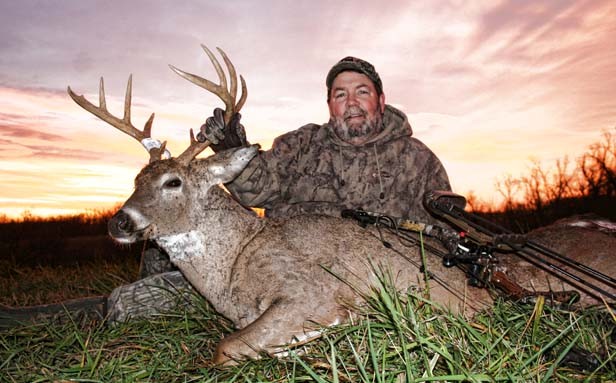
A buffet table for deer
Robertson has barely settled into position when a pair of does appear, perhaps 250 yards distant and dead ahead.
“What, we’re here for five minutes, maybe, and the deer are out,” he whispers. “Pike County, baby!”
Blissfully unaware – and completely safe, given that Robertson’s range with a bow is 30 yards – the does graze, pulling up tufts of oats and looking up every minute or two to survey their surroundings, just in case. After 15 minutes, a yearling buck joins them. They all look beautiful. Tasty. And stupid. Sundown, when hunting by law must end, is still more than two hours away.
“Believe me, he’s not the only buck in these woods,” Robertson says. “By six o’clock, this should be really good.”
Five years ago, after a half-century of legal deer hunting in Illinois, the Illinois General Assembly did what politicians are prone to do when confronted with a potentially controversial issue: It set up a task force.
“Deer overpopulation is rampant in some counties in Illinois, causing accidents on our highways, increasing crop damage for Illinois farmers, and making it easier for disease and starvation to afflict our deer populations,” read a whereas at the top of the resolution that described all sorts of other havoc and passed both chambers unanimously.
Even a deer, which has a brain the size of a walnut, could predict where this was headed. Sure enough, the state Joint Task Force On Deer Population Control, which included members of the agricultural committees of both chambers, a representative from the Illinois Insurance Association, someone from the Illinois Farm Bureau and a member of United Bowhunters of Illinois, recommended longer hunting seasons and over-the-counter sale of deer tags, which had been distributed via lottery. The recommendations were implemented, and the number of deer killed each year in Illinois now number nearly 200,000. The measure of success, the task force decreed, would be the number of deer versus vehicle accidents, which had peaked in 2003 at 241 per billion miles driven. The number of accidents, which had risen to more than 25,000 a year in 2003, fell to 18,039 last year, and the number of accidents per vehicle mile traveled has dipped to levels not seen since the 1990s, Shelton says.
“We pretty much reached our goal,” says Shelton, who figures the deer population has fallen by nearly 100,000 from its peak around eight years ago and now stands at approximately 700,000, which works out to one deer for every 18 people in the state.
Brad Zara, owner of Zara Collision Center in Springfield, is seeing a difference. His auto body repair shop has been taking in one car-versus-deer case a day. Zara says that’s low for a shop that usually sees at least 50 such cases a year, with an average repair bill of about $5,000. He guesses that the drought might have caused deer to go looking for water instead of running across roads, but that’s just a guess.
“Each year, we always wonder what gets them moving and try to figure out their way of thinking,” Zara says. “I don’t know if there’s any sound reasoning behind things.”
When it comes to deer, Shelton says, specifics aren’t always important.
Top 10 counties for deer hunting, 2011
Far and away, Pike County produces more venison than any county in Illinois, where more than 181,000 deer were dispatched by bow, shotgun, muzzleloader, handgun and crossbow last year. The county an hour west of Springfield produced four times as many deer for hunters as Sangamon County, where 1,770 deer were killed. Cook finished at the bottom, with just 167 deer killed, all by archers. Here’s a look at the top 10:
| County | Deer killed |
| 1. Pike | 7,179 |
| 2. Fulton | 5,170 |
| 3. Adams | 4,363 |
| 4. Jefferson | 4,360 |
| 5. JoDaviess | 3,886 |
| 6. Randolph | 3,626 |
| 7. Wayne | 3,401 |
| 8. Marion | 3,396 |
| 9. Hancock | 3,227 |
| 10. Jackson | 3,210 |
“The fact of the matter is, we don’t have to know how many deer there are,” Shelton says. “In many cases, we’re better off not even trying to estimate an exact number. There’s no way of proving it. All we need to know to manage deer here in Illinois is whether the herd is increasing, decreasing or stable. All we have to know is, are people satisfied with the existing level of deer? If people have their fill of deer and it’s still increasing, you’re in trouble.”
Biologists agree there are likely more deer in the Land of Lincoln today than when the Pilgrims landed. Deer, Shelton explains, are creatures of the edge that thrive in places where forest meets field, and farmers have created a lot of edges in Illinois.
“Things have never been better for our deer population,” Shelton says. “Illinois is like a buffet table for deer. Quite frankly, Illinois will support more deer than anybody in their right mind is going to accept.”
No two people are likely to agree on how many deer is the right number, and so deer management is as much about politics as biology. Hunters will nearly always want more deer, farmers and motorists who just had a buck fly through the windshield usually want fewer and the rest of us are somewhere in between. Shelton, who has worked for the Department of Natural Resources for two decades, easily recalls the ying and yang: During the early 1990s, the General Assembly thought something should be done about the rising deer population, but hunters protested when the state allowed a larger harvest, and so the state backed off, which led to more deer, which led to the General Assembly creating the deer-population task force five years ago.
Hunters can take just two antlered bucks per season, and deer are also rationed during the firearms hunting season that lasts seven days, with another seven days in 56 counties, including Sangamon, for deer without antlers – the shooting will start on Nov. 18. But the bottom line is, there is no real limit on the number of deer Illinois hunters can kill. Archery season, which began Oct. 1, doesn’t end until Jan. 20, and archers can take as many does as they like during the season that lasts more than three months.
The best place to hunt
By ones and twos, more deer show up in the oat field as the shadows lengthen. Eventually, eight deer, including two bucks, are grazing, still out of range, but perhaps not for long. While an eight-pointer holds back, the yearling buck leads the way, meandering to within a football field of Robertson’s blind.
“They’re all kind of moving this way,” Robertson notes. “And we’ve still got a half-hour to go.”
The number of hunters is dwindling in most states, but not in Illinois, where about 270,000 licenses for hunting by bow and firearm were issued last year.
“For the past two years, it’s been stable,” Shelton says. “The long-term trend is increasing. You have to look at the opportunity: Illinois is the land of plenty when it comes to deer.”
Jack Campbell, undersheriff at the Sangamon County sheriff’s office, is part of the trend. He shot his first deer as a 12-year-old boy in 1976 by trudging down to the Sangamon River, sitting on an upside-down bucket next to a tree and just waiting. He did even better the following year when he bagged a 10-point buck using the same technique. He saw nothing at all for the next four years and gave up hunting, figuring that just sitting around was boring. No longer.
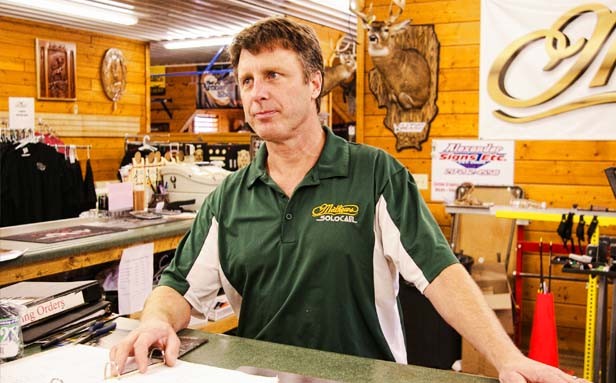
“I’ve sat from sunup to sundown in my deer stand,” Campbell says. “It’s kind of a soothing effect. I like watching the squirrels and raccoons. It just helps me de-stress for awhile. I think about work. I think about my family.”
And, of course, he thinks about deer. It has gotten to the point where Campbell now owns a trail cam to photograph deer that pass through an infrared beam, triggering the shutter.
“It’s like Christmas morning when you go get your memory card out of your trail camera,” says Campbell, who does just fine hunting in Sangamon County.
While deer hunting is better than ever in Illinois, big bucks have grown difficult to bag with a shotgun, Campbell says, because the monsters go into hiding with the advent of bow-hunting season, which starts more than a month before firearms are allowed. And so Campbell recently took up bow hunting. He bagged a buck in late October, but isn’t finished for the year.
“I went out and got another tag,” Campbell says.
Campbell tends to give away his venison and he’s not alone. In Pike County, Tom Magro, whose family owns an Auburn meat-processing plant, collects carcasses from hunters who either have all the venison they need or don’t care for deer meat and distributes the donated venison to food pantries. Last year, seven tons of Bambi burger fed the hungry through the state program called Sportsmen Against Hunger, Magro says. To keep things fair, all the venison, including tenderloins and steaks, are ground up and distributed in the same counties – Pike, Sangamon and Brown – where the deer were killed.
In Pike County, deer hunting has turned into big business, with farmers leasing land to out-of-staters willing to pay thousands of dollars for exclusive hunting privileges. And that has caused some hard feelings among locals who once hunted for free but can no longer expect to be welcomed when they ask if it’s OK to set up a deer stand.
“Everybody’s putting hunters up in their basements and spare rooms,” says Scott Andress, owner of Pike County Archery, a 5,000-square-foot shop in Pittsfield that’s been open for a dozen years. “Everybody’s figured out how to make a dime out of it. The days of free hunting are over.”
While deer afford a living for Andress, he says he thinks that his profits would be bigger if Pike County hadn’t become internationally famous – and exclusive – through stories in hunting magazines and features on hunting television programs.
“I’d be making more money,” he says. “There’d be more people hunting, more people buying bows. There’s a tremendous number of local guys who can’t hunt around here because they can’t afford it.”
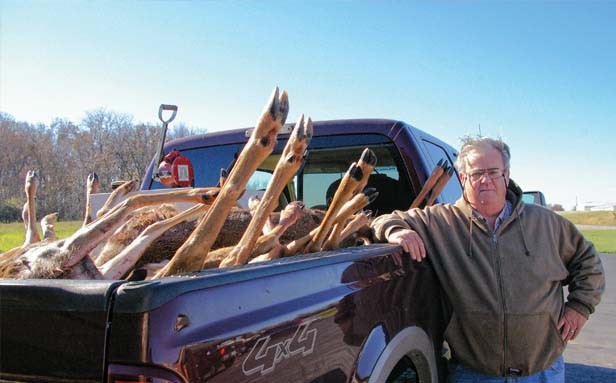
Despite more than a decade in the international hunting spotlight, Pike County still leads the state in the number of deer killed each year. Andress doesn’t think there are as many big bucks as there once were, but two- and three-year-old bucks are still common and big, he says.
“This is probably the only place in the United States that can produce this level of deer,” Andress says.
Shelton chuckles at the notion that there are no big bucks left in Pike County.
“They have said that since 1957,” Shelton says. “If you look at the age structure of our harvest – how many of the deer we’re taking are young – the age structure that is coming out of those counties over there is as good as it ever was. The best season we’ve ever seen was always in the past – that’s human nature.”
Someone has to deal with all the venison and Magro is that person. He started out in a garage in 1989, when he processed 14 deer. He processed 30 the next year. Now, the family’s meat-processing plant goes full-tilt deer each autumn, ceasing the production of beef and pork when the rut begins. Last year, the plant, which employs about a dozen people, made 1,100 deer ready to eat. It’s a six-figure business, considering basic processing costs $129 for a buck, $119 for a doe and $89 for a fawn, with sausage costing extra.
“When the trigger gets pulled or the arrow flies, that’s when the fun’s over,” Magro says.
The buck is in the killing zone.
With minutes of daylight left, the eight-pointer has sauntered the length of the oat field and now stands within 50 feet of Robertson, who has passed up shots on the yearling buck and two does who preceded this beast, wandering down the field to the blind.
The other deer were dumb, ambling past while the wind blew north, carrying Robertson’s scent right to them. This buck, however, halts as he nears the blind. Something is different than it was when he last came through here, and he doesn’t stick around to find out what it is. He reaches the treeline in a blink and a few bounds. Today was not his day, and that was the choice of Robertson, who never reached for his bow.
“He was just a little too small,” the archer says.
Contact Bruce Rushton at [email protected].

